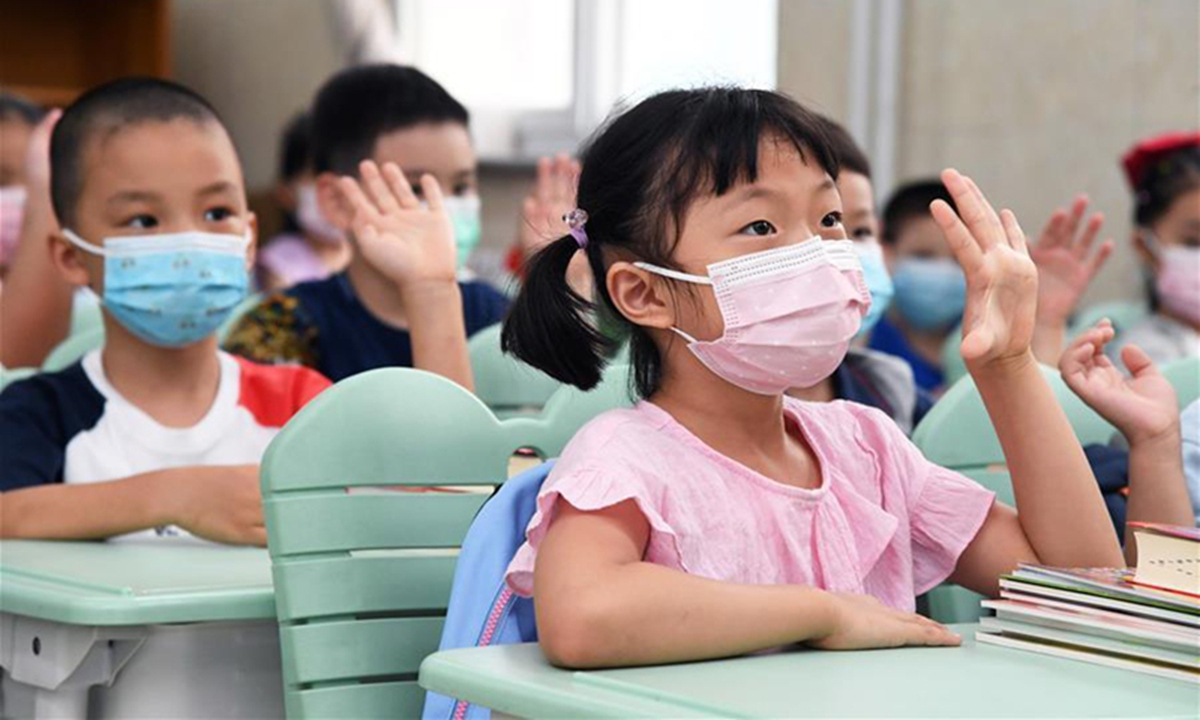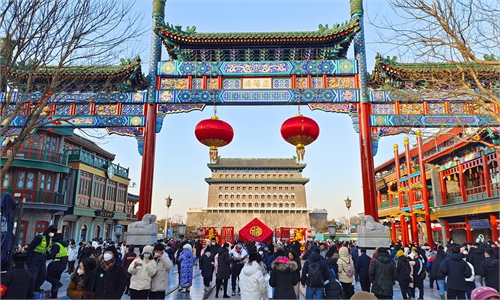
First graders have class at Taipinglu Primary School in Haidian District, Beijing. Photo: Xinhua
A high-profile meeting on economic policy held in Beijing last week listed population and the people's education as one of the nation's top priorities in the coming years, together with shoring up industrial supply chain and economic security.As widely reported, the country's total population dropped by 850,000 persons in 2022 from the previous year, registering the first decline in more than 60 years. Preventing a precipitous drop in child-births while continuing to improve education levels across the working population will be a major task facing the nation's policymakers.
The meeting announced that relevant central government departments will chart specific measures this year to incentivize child-bearing and births, substantially reduce fees associated with children's rearing and pre-school education, in addition to extending the official retirement age and promoting female employment - all effective measures needed to sustain economic growth and boost household income.
Since 1980 when the country implemented the one-child family planning policy, drastic demographic changes have taken place, as China's population ages. According to official data, from 1980 to 2020, the proportion of the non-adult population halved from 36.2 percent to 18.1 percent, while the elderly population rose from 6.9 percent to 17.6 percent.
The proportion of the working-age population rose from 57.1 percent in 1980 to 69.2 percent in 2007, before sliding to 64.2 percent in 2020. The figures show that the demographic bonus that supported economic growth is now receding, and may become a demographic burden as the population ages, pundits claim.
Last October, the 20th National Congress of the Communist Party of China took note of the evolving demographics, stating that the nation will do its utmost to phase in a new policy structure to boost fertility and birth rates through cutting costs associated with pregnancy and childbirth as well as schooling from kindergarten to college and university. Also, it asked the authorities in charge of the nation's human resources to start considering a new mandate - when to raise the retirement age which is currently 60 years for men and 55 years for most women.
The nation has gradually eased its one-child policy over recent years. The most recent change came in 2021 when the Central Government approved a pro-birth policy to allow married couples to have up to three children. Despite this, fertility rates have not recovered in the past several years. Given the urgency of the problem, all birth restrictions will eventually have to be eliminated - the sooner, the better.
The low birthrate and aging population are expected to continue over coming years unless drastic measures and changes happen. According to a research paper by the United Nations, by 2050, the proportion of China's child population will fall to 11.4 percent, and that of the working-age population will decrease to 49.7 percent, while the proportion of the elderly population will rise to 38.8 percent. One prime factor behind the aging of the population is sustained rise in life expectancy. In 2050, China's life expectancy will rise to 83.8 years from a current 78.2 years.
From 1980 to 2020, fertility rates fell from 2.74 to a lowly 1.29. If the current social trend toward declining female fertility, late marriage, and even non-marriage continues unabated, by 2050, China's total population is likely to shrink to 1.32 billion from the peak of 1.426 billion in 2021, according to the UN report.
The low birthrate is primarily due to the one-child policy implemented from 1980 to 2015, and the resulting drop in the proportion of the working-age population will act as a constraint on economic development, demography experts say. While low birthrates and population aging are phenomena common to the developed economies, China will likely face increasing challenges over coming years.
Nevertheless, not all demography experts agree on this. Some say that China saw new birth of 9.56 million in 2022, a number that far outstrips the combined new births in 27 EU countries and the US. And, in the foreseeable future, China will not face a population crisis as alleged by some Western pundits. And, Chinese economists say the country has a large cohort of rural labor that could help fill assembly line gaps in urban factories and many service sectors.
With the country yet to realize complete Chinese-style modernization and societal prosperity, the low fertility rate and aging population pose a significant challenge to socioeconomic development. However, it should be noted that despite the challenges, aging does not necessarily become an obstacle to achieving modernization.
Official data shows that the unemployment rate for the age group of 16-24 years is 16.7 percent at the end of 2022, which indicates that China is not short of young workers at all, and the government may not need to rush to prolong the retirement age for Chinese workers shortly.
Further, Chinese households are renowned for saving money, which will continue to provide firm support to economic growth - an advantage that other developed countries are envious. Chinese households' average savings rate remains elevated at 45.9 percent of their annual earnings, which means the nation still has a large capital accumulation base which will back up investment and market demand, coupled with increasingly ramped-up industrial upgrading and technology innovations.
Improvement in productivity will ease the problem of aging population too. In the coming years, the number of college graduates is estimated to hover at 10 million every year, which will provide sufficient human resources to bolster economic growth and indicates China's demographic dividend is shifting from quantity to quality. In addition, the nation should fully utilize the market mechanism to promote private entrepreneurship and stimulate broad innovations to sustain economic growth.
The author is an editor with the Global Times. bizopinion@globaltimes.com.cn



